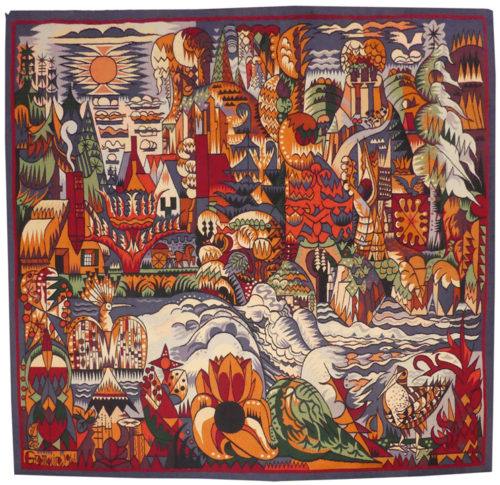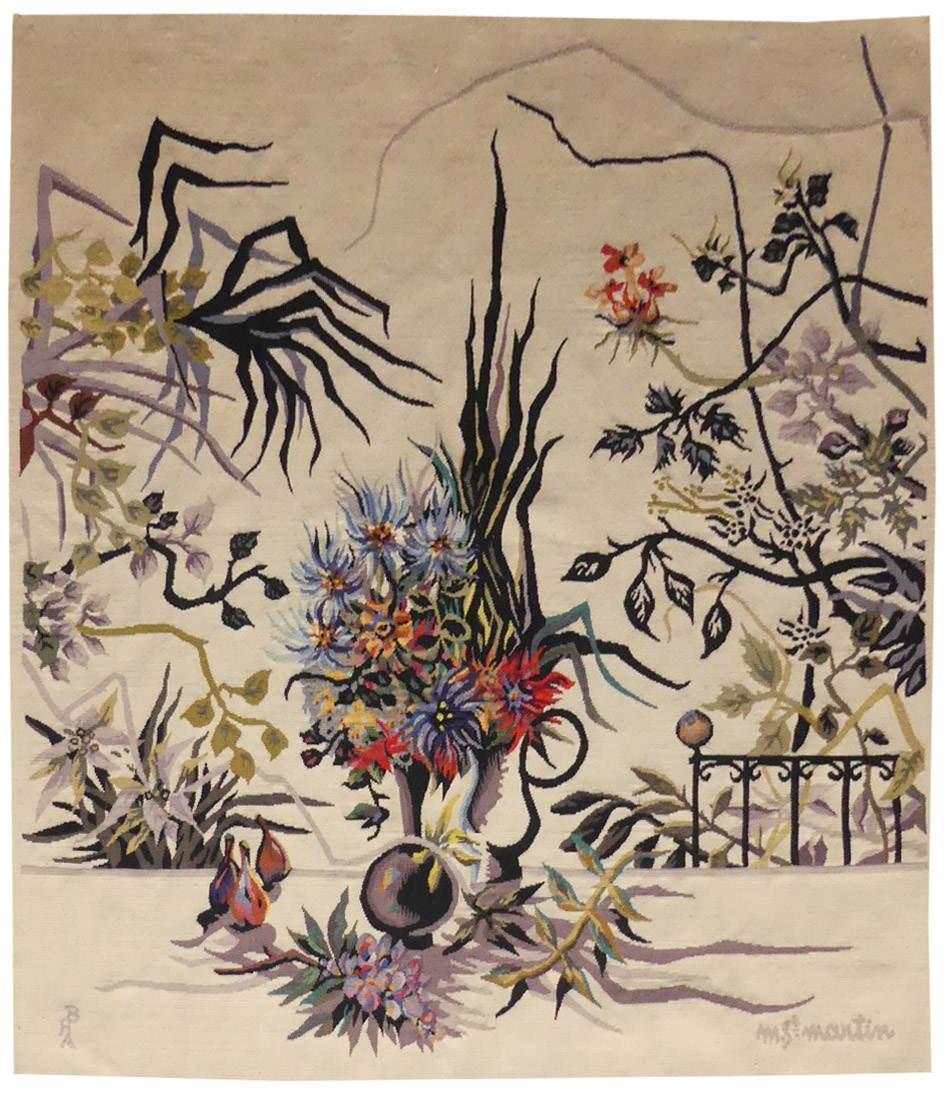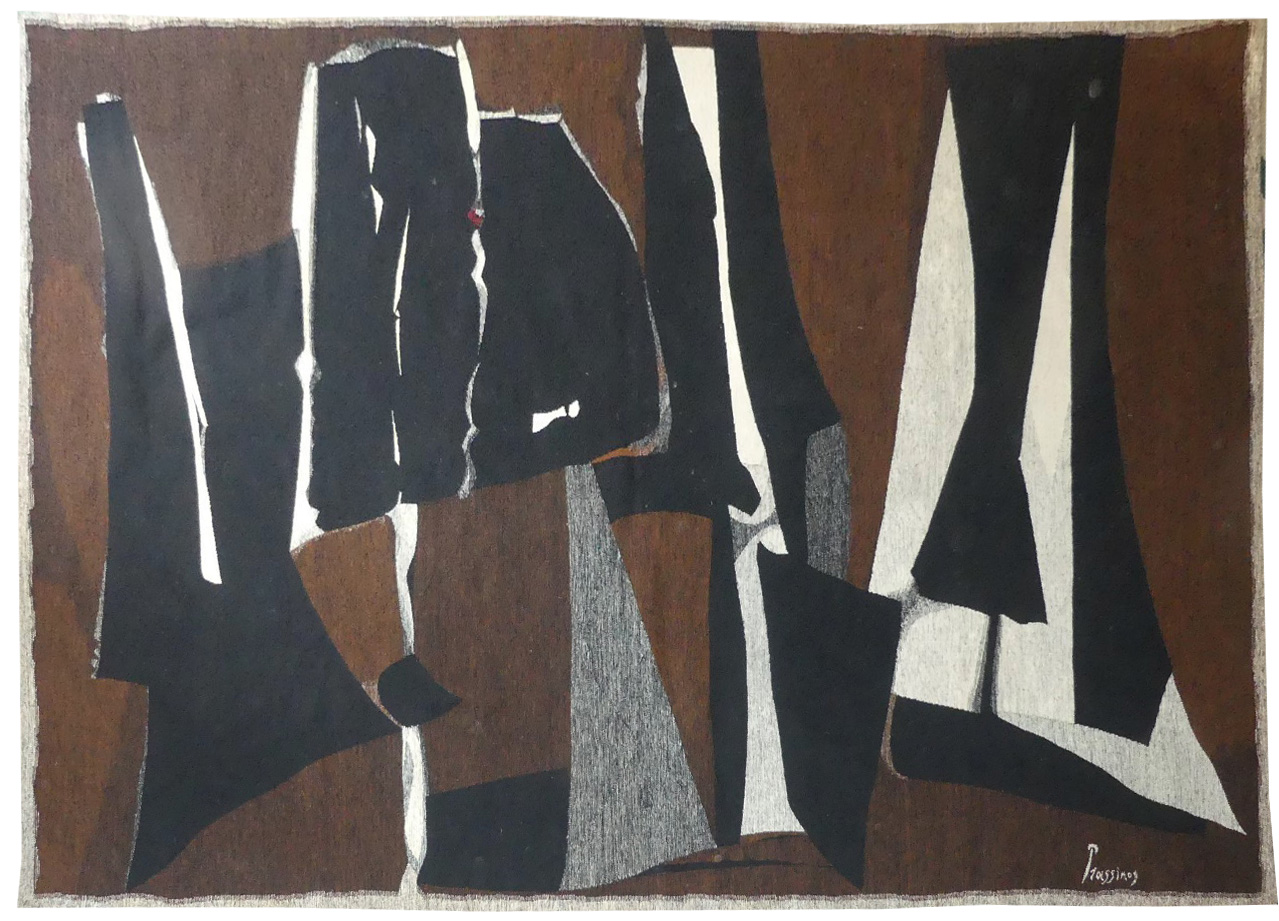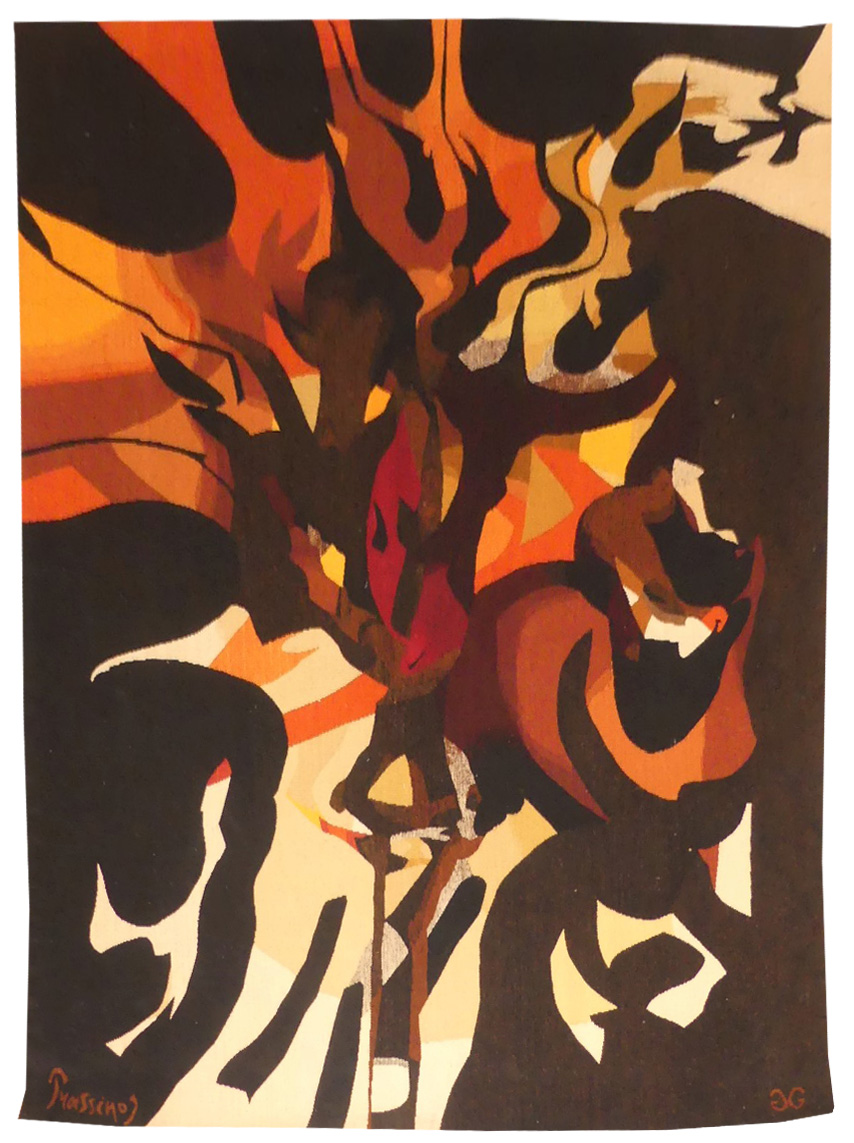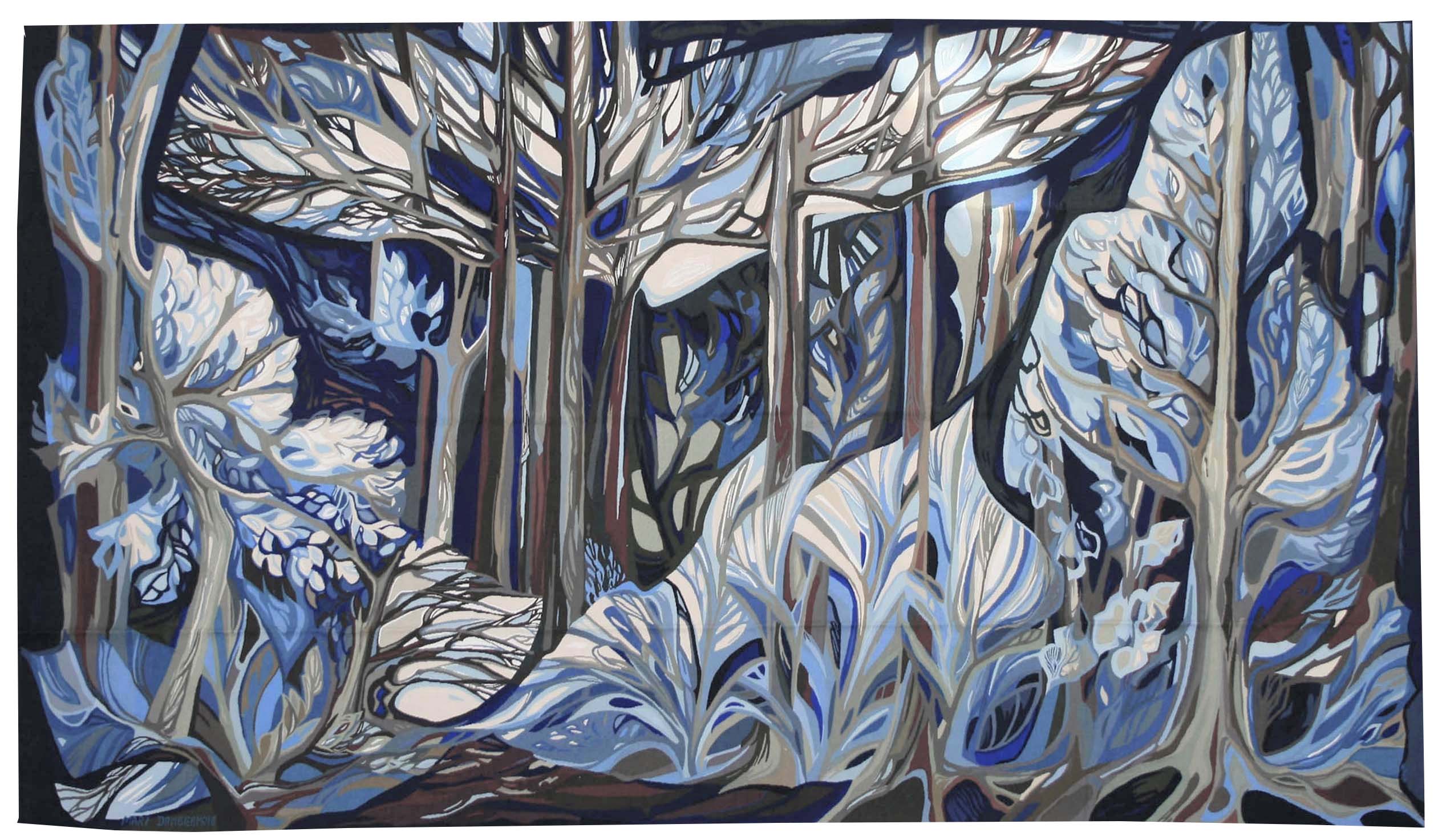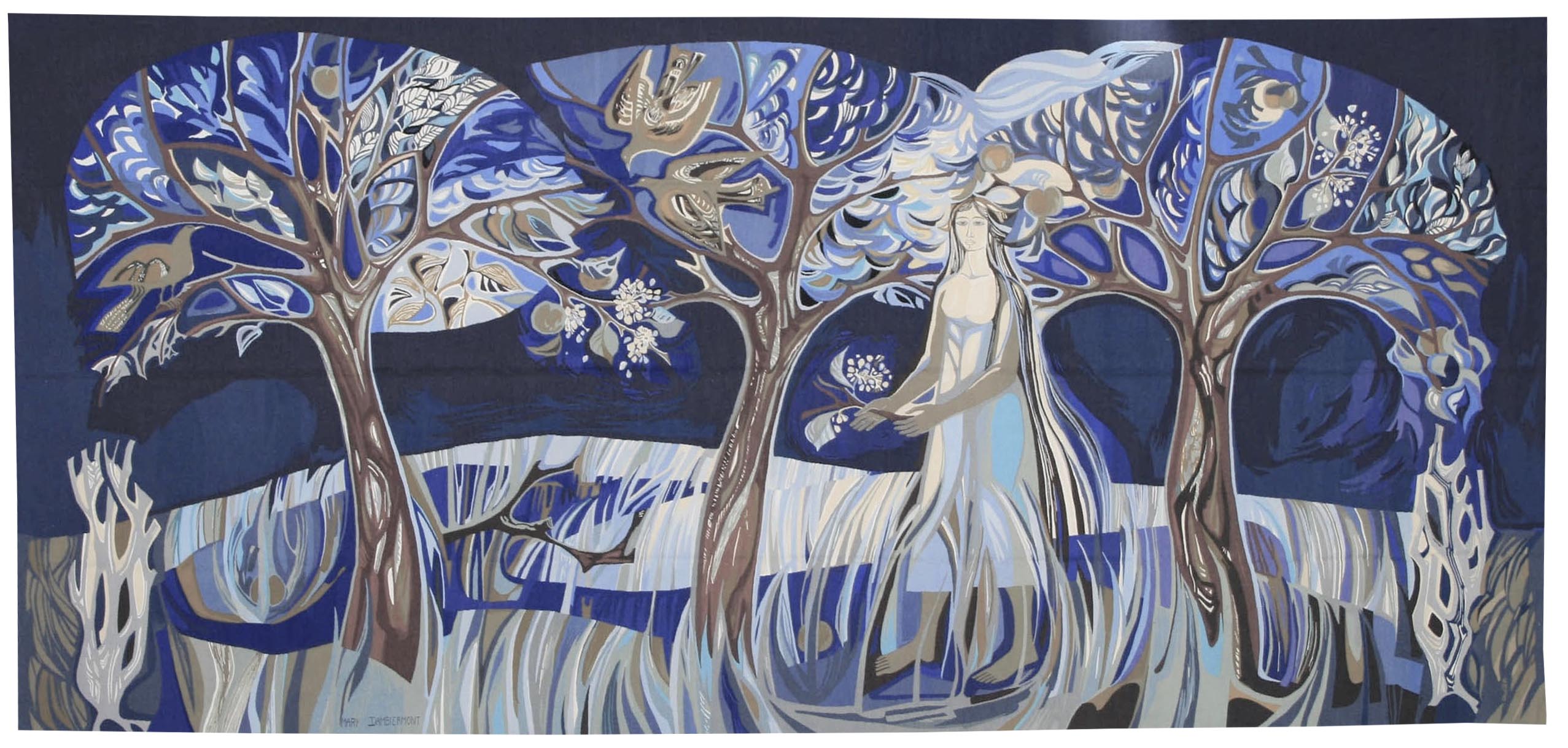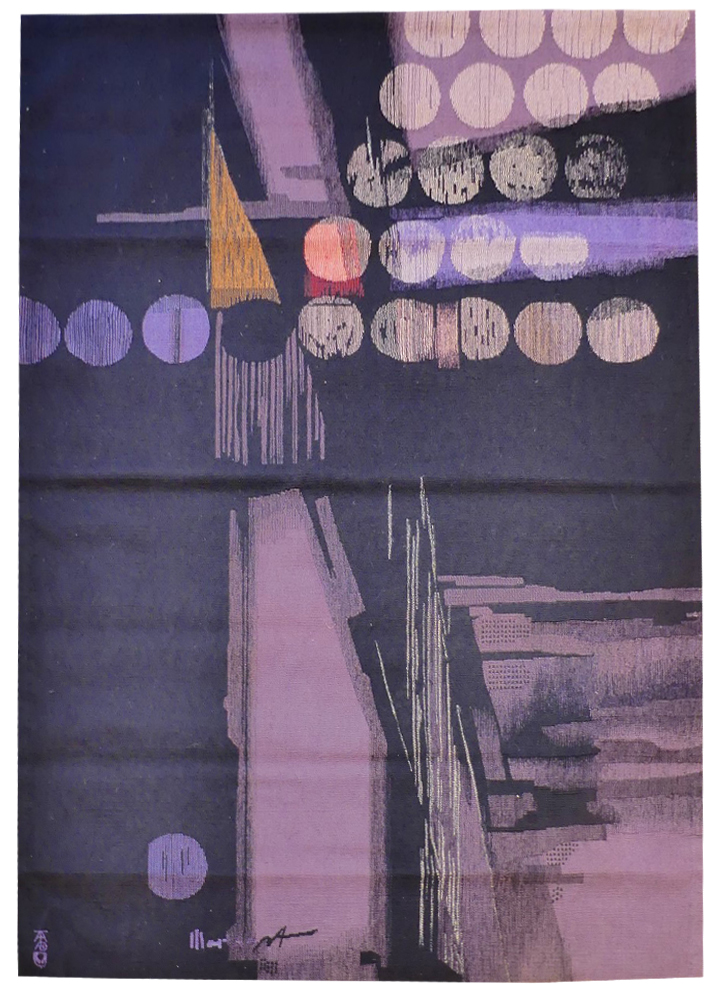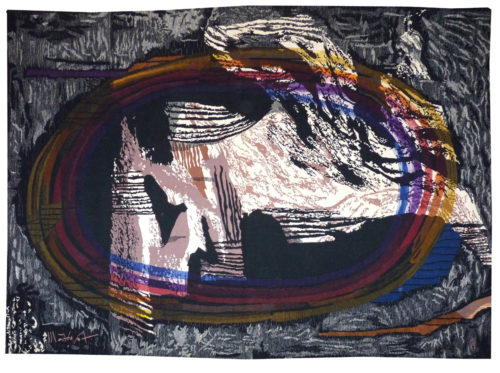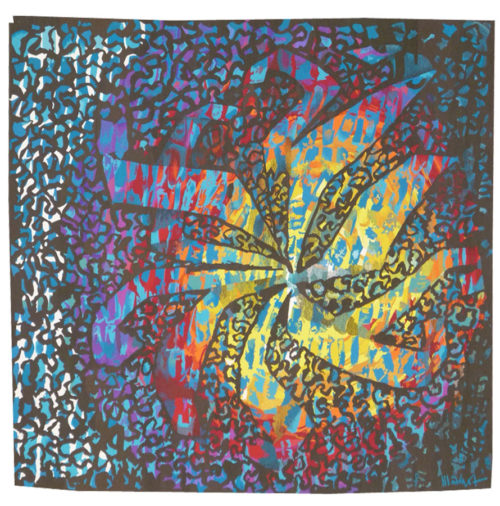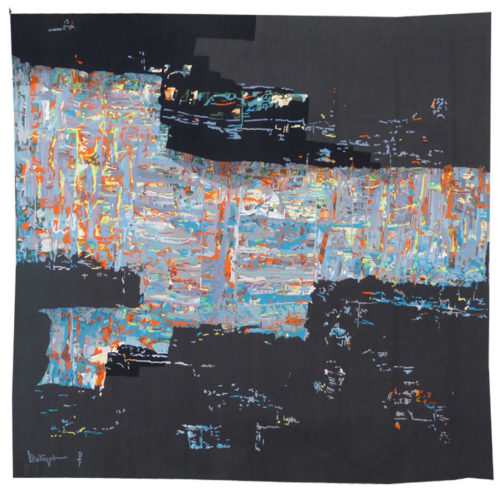-
Multi-talented artist (poet, lyricist, painter and even antiques dealer,…) Saint-Martin, who assisted Lurçat at the beginning of the 1950’s, started designing his own cartoons in 1956 and they were woven in the Braquenié workshop. His is a dream-like, stylised and dramatised world : here, symbols of order and discipline (the still life composition, the wrought iron balustrade...) contrast with the unsettling, unfettered profusion of the branches on each side.Aubusson tapestry woven by the Braquenié workshop. With label. Circa 1960.
-
Les six cyprès (the six cypresses)
Aubusson tapestry woven in the Goubely workshop. With signed label. 1957. I became interested in the art of tapestry particularly because I was excited by the numbered cartoon technique consisting of the fabrication of a mental coloured image using a code…. Tapestry is an essential exercise. As I practised it, it is perhaps the desire to interrogate, down to the finest detail, a work which exists in two dimensions.” (quoted in the exhibition catalogue, Prassinos, rétrospective de l’oeuvre peint et dessiné, Puyricard, 1983). So much for the artist’s manifesto. Prassinos designed his first cartoons in 1951 (most of which, around 150, would be woven in the Goubely workshop); then he joined the A.P.C.T. (Association des Peintres-Cartonniers de Tapisserie). After several cartoons taking birds as their theme, Prassinos, like several other artists, despite being close to Lurçat, (Matégot, Wogensky…) turned resolutely towards abstraction, in a very personal style where sinuous shapes entwine in contrasting colours (often following a scheme of black-red-brown-beige). Prassinos moved to Eygalières in 1951 and his first tapestries were designed at the same period : « Cyprès noir » and « Cyprès rouge », both from 1952, number among his very first cartoons, echoing the simultaneous discovery of a locality and a technique. Here the subject is revisited on a larger scale ; one of the 3 originals is in the possession of the Musée Municipal d’Arnhem. Bibliography : Exhibition Catalogue Mario Prassinos, œuvre tissé, Galerie la Demeure, 1961, ill. p.20-21 Exhibition catalogue Mario Prassinos, tapisseries monumentales, Abbaye de Montmajour, Arles, 1974 Mario Prassinos, œuvre tissé, La Demeure, 1974, n°20 Exhibition catalogue Mario Prassinos, Tapisseries , Aubusson, Musée départemental de le Tapisserie, 1984 Exhibition catalogue Prassinos, Tapisseries, Angers, Musée Jean Lurçat et de la Tapisserie Contemporaine, 1988 -
Haute flamme (High flame)
Aubusson tapestry woven in the Goubely workshop. N°4/4. 1966. I became interested in the art of tapestry particularly because I was excited by the numbered cartoon technique consisting of the fabrication of a mental coloured image using a code…. Tapestry is an essential exercise. As I practised it, it is perhaps the desire to interrogate, down to the finest detail, a work which exists in two dimensions.” (quoted in the exhibition catalogue, Prassinos, rétrospective de l’oeuvre peint et dessiné, Puyricard, 1983). So much for the artist’s manifesto. Prassinos designed his first cartoons in 1951 (most of which, around 150, would be woven in the Goubely workshop); then he joined the A.P.C.T. (Association des Peintres-Cartonniers de Tapisserie). After several cartoons taking birds as their theme, Prassinos, like several other artists, despite being close to Lurçat, (Matégot, Wogensky…) turned resolutely towards abstraction, in a very personal style where sinuous shapes entwine in contrasting colours (often following a scheme of black-red-brown-beige). In a way there is in this cartoon a return to the figurative. However, more probably, the artist’s characteristic formal and chromatic conceptions are here allowed retrospectively to incarnate something which is generally, and paradoxically, impossible to represent and thus become conflagration, flame, wild fires (in Greece ? the Alpilles ?) Bibliography : Exhibition catalogue Mario Prassinos, tapisseries monumentales, Abbaye de Montmajour, Arles, 1974 Mario Prassinos, œuvre tissé, La Demeure, 1974, n°72 (Ill.) Exhibition catalogue Mario Prassinos, Tapisseries , Aubusson, Musée départemental de le Tapisserie, 1984 Exhibition catalogue Prassinos, Tapisseries, Angers, Musée Jean Lurçat et de la Tapisserie Contemporaine, 1988 -
La sylve (the forest)
Representing the prolific Belgian school of modern tapestry, Mary Dambiermont, is one of its most sensitive protagonists whose work is resolutely figurative. She made her tapestry début at the age of 24 in 1956 and that led her to a close collaboration with the Braquenié establishment in 1958 and from there to two participations in the Biennales de tapisserie in Lausanne in 1962 and 1965. The world she inhabits is a singular place peopled with hieratic figures, often feminine who inhabit dream-like landscapes which are strange and occasionally troubling. Sometimes however, nature is sufficient unto itself, although not often on the scale of this work (12 m2 !), abandoning any attempt at storytelling, as if an echo of bygone times in the history of Tapestry making : “With its twentieth century foliage, it reveals the ancient architecture of an immutable forest.” (Paul Caso, Mary Dambiermont, p.56) Bibliography : Paul Caso, Mary Dambiermont, Editions Arts et voyages, 1975, ill p.54-55Tapestry woven by the Braquenié workshop. With label. 1968. -
Le verger (the orchard)
Representing the prolific Belgian school of modern tapestry, Mary Dambiermont, is one of its most sensitive protagonists whose work is resolutely figurative. She made her tapestry début at the age of 24 in 1956 and that led her to a close collaboration with the Braquenié establishment in 1958 and from there to two participations in the Biennales de tapisserie in Lausanne in 1962 and 1965. The world she inhabits is a singular place peopled with hieratic figures, often feminine who inhabit dream-like landscapes which are strange and occasionally troubling. This cartoon, shown at the biennale in Lausanne, is a development of the contemporary theme of enclosure (20 works exhibited in 1966), which is itself an echo of the mediaeval « hortus conclusus ». Bibliography : Cat. Expo. 2e biennale internationale de la tapisserie, Lausanne, Musée cantonal des beaux-arts, 1965, ill. p.19 Paul Caso, Mary Dambiermont, Editions Arts et voyages, 1975, ill p.42-43Tapestry woven by the Braquenié workshop. With label. 1965. -
Cap Canaveral (Cape Canaveral)
Aubusson tapestry woven by the Tabard workshop. With signed label, n°2/6. Circa 1970. -
Remous (swell)
Aubusson tapestry woven in the Tabard workshop. Circa 1960. Matégot, originally a decorator, then creator of artefacts and furniture (an activity he abandoned in 1959) met François Tabard in 1945 and gave him his first cartoons, first of all figurative then rapidly of abstract design in the 1950’s. He became a member of the A.P.C.T. (Association des Peintres Cartonniers de Tapisserie) in 1949, participated in many international exhibitions (Matégot, like Lurçat before him, was an untiring advocate of the art of tapestry) fulfilled numerous public commissions, sometimes of monumental proportions (“Rouen” 85m2 for the Préfecture of the Seine Maritime département, and also tapestries for Orly Airport, for the Maison de la Radio, for the IMF...) and designed no fewer than 629 cartoons up until the 1970’s. In 1990 the Matégot foundation for contemporary tapestry was inaugurated in Bethesda, U.S.A. Matégot is an artist, like Wogensky, Tourlière or Prassinos, who turns wool textiles resolutely towards the abstract: at first lyrical, geometric in the 70’s, exploiting various technical aspects of the loom : colour graduations, shading, irregularities... Remous can be seen as representative of Matégot’s production around 1960 : lyrical, playing with transparency, using all the technical expertise of the weavers (colour shading and grading…) Its evocative title is a reminder of the artist’s interest for aquatic subjects (cf “Régates”) treated in an abstract-metaphorical way. Bibliography : Exhibition Cat. Les tapisseries de Mathieu Matégot, galerie La Demeure, 1962 (ill.) Exhibition catalogue, Matégot, Angers, Musée Jean Lurçat et de la Tapisserie Contemporaine, 1990-1991 -
Le soleil de Tijuana (the Tijuana sun)
Aubusson tapestry woven in the Pinton workshop. Signed certificate of origin. Circa 1960. Matégot, originally a decorator, then creator of artefacts and furniture (an activity he abandoned in 1959) met François Tabard in 1945 and gave him his first cartoons, first of all figurative then rapidly of abstract design in the 1950’s. He became a member of the A.P.C.T. (Association des Peintres Cartonniers de Tapisserie) in 1949, participated in many international exhibitions (Matégot, like Lurçat before him, was an untiring advocate of the art of tapestry) fulfilled numerous public commissions, sometimes of monumental proportions (“Rouen” 85m2 for the Préfecture of the Seine Maritime département, and also tapestries for Orly Airport, for the Maison de la Radio, for the IMF...) and designed no fewer than 629 cartoons up until the 1970’s. In 1990 the Matégot foundation for contemporary tapestry was inaugurated in Bethesda, U.S.A. Matégot is an artist, like Wogensky, Tourlière or Prassinos, who turns wool textiles resolutely towards the abstract: at first lyrical, geometric in the 70’s, exploiting various technical aspects of the loom : colour graduations, shading, irregularities... Matégot, recognised as an avant garde designer, an admired creator of furniture and decorative objects, also produced an essentially abstract body of tapestry work. However this is not an example of pure abstraction : but rather the evocation of a place (there are also “Mindanao”, “Santa Barbara”....) of its climate, using all the technical means offered by the medium : transparency, graduations, shading... Origin : contents of the Pinton workshop Bibliography : Exhibition catalogue, Matégot, Angers, Musée Jean Lurçat et de la Tapisserie Contemporaine, 1990-1991 -
Ombres et lumières (light and shadow)
Aubusson tapestry woven in the Pinton workshop. Complete with certificate of origin signed by the artist. Circa 1965. Matégot, originally a decorator, then creator of artefacts and furniture (an activity he abandoned in 1959) met François Tabard in 1945 and gave him his first cartoons, first of all figurative then rapidly of abstract design in the 1950’s. He became a member of the A.P.C.T. (Association des Peintres Cartonniers de Tapisserie) in 1949, participated in many international exhibitions (Matégot, like Lurçat before him, was an untiring advocate of the art of tapestry) fulfilled numerous public commissions, sometimes of monumental proportions (“Rouen” 85m2 for the Préfecture of the Seine Maritime département, and also tapestries for Orly Airport, for the Maison de la Radio, for the IMF...) and designed no fewer than 629 cartoons up until the 1970’s. In 1990 the Matégot foundation for contemporary tapestry was inaugurated in Bethesda, U.S.A. Matégot is an artist, like Wogensky, Tourlière or Prassinos, who turns wool textiles resolutely towards the abstract: at first lyrical, geometric in the 70’s, exploiting various technical aspects of the loom : colour graduations, shading, irregularities... This tapestry reveals Matégot’s preoccupation with the interplay of light and shadow which is often revealed in the titles of his works (cf. “Lumière d’été”, auctioned Millon-Robert 7.11.90, n° 31, reproduced on the cover of the catalogue, “Piège de lumière” preserved at the Musée Jean Lurçat et de la Tapisserie Contemporaine and reproduced p 47 of the exhibition catalogue). Here the cartoon uses an abrupt contrast, like a ray of light, between two opaque (with faults however) and black (but shaded) blocks. In fact all of Matégot’s works reveal the interplay of transparency and superposition, as if light (albeit fatal to the colours he uses) was trying to force its way through the wool. Origin : contents of the Pinton workshop Bibliography : Exhibition catalogue, Matégot, Angers, Musée Jean Lurçat et de la Tapisserie Contemporaine, 1990-1991


